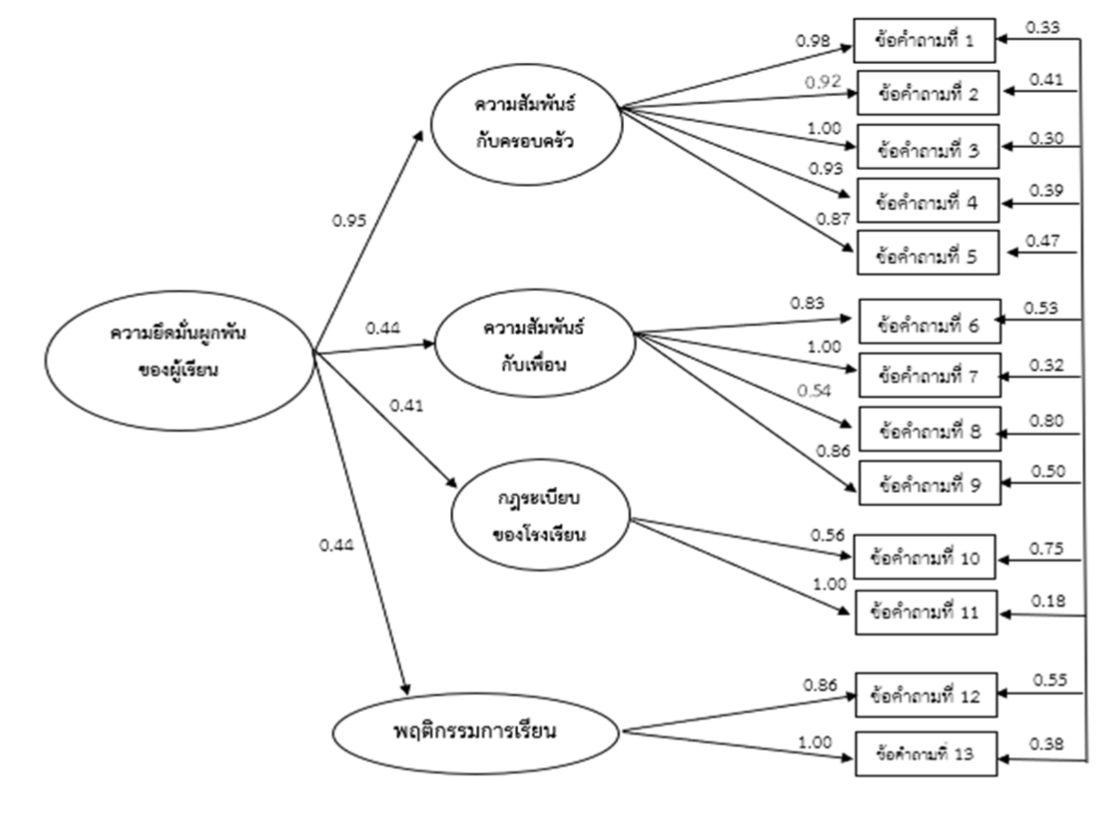Factor and Latent Profile Analyses of Student Engagement of Lower Secondary School Students in Bangkok
Main Article Content
Abstract
The purposes of this study were 1) to analyze the factor of student engagement of lower secondary school students in Bangkok and to examine the quality of the student engagement scale after analyzing the factor 2) to analyze the profile group of lower secondary school students according to the level of student engagement and 3) to analyze the correlation between GPA and student engagement score. The data were collected via student engagement scale, a 4-point self-report rating scale. The data were analysis by using validity, reliability, item discrimination 2) latent profile analysis and 3) Pearson's correlation coefficient analysis.
The research finding was showed that 1) Student engagement consisted of 4 factors include relationship with family, relationship with friends, school compliance and behavioral engagement in learning. Measurement model that created after EFA was fit (X2 = 42.29; df = 29; p-value = .053; RMSEA = 0.017). The quality of the scale showed that met requirement of criteria of validity, reliability, and discrimination. 2) The student engagement model that consisted of 5 profile groups was the most fit (LL = -6360.634, BIC = -12927.260). and 3) The GPA was a high positively correlated at statistically significant level of .01 with the student engagement total score (r = .804) and all factors of student engagement (r = .707 - .771).
Article Details
References
ทัศนี ประสบกิตติคุณ, & ฟองคำ ติลกสกุลชัย. (2554). แบบสอบถามการรับรู้สมรรถนะของตนเองในการดูแลทารก:การวิเคราะห์ข้อคำถาม. Journal of Nursing Science, 29(3), 43-51.
ธรรมโชติ เอี่ยมทัศนะ, นฤมล พระใหญ่, รัญจวน คำวชิรพิทักษ์, & วรนุช แหยมแสง. (2560). โมเดลความสัมพันธ์เชิงสาเหตุของปัจจัยส่วนบุคคลและปัจจัยทางสังคมที่มีต่อความยึดมั่นผูกพันของผู้เรียนระดับมัธยมศึกษาตอนปลาย. Veridian E-Journal, Silpakorn University ฉบับภาษาไทย, 10(3), 52-67.
นงลักษณ์ วิรัชชัย. (2555). การวิเคราะห์องค์ประกอบเชิงยืนยัน. วารสารวิจัยและพัฒนาหลักสูตร, 2(1), 68-74.
วิไลลักษณ์ ลังกา. (2558). โมเดลความสัมพันธ์โครงสร้างเชิงเส้น. สารานุกรมศึกษาศาสตร์, 50(2558), 105-114.
ศิริชัย กาญจนวาสี. (2556). ทฤษฎีการทดสอบแบบดั้งเดิม. กรุงเทพมหานคร: โรงพิมพ์แห่งจุฬาลงกรณ์มหาวิทยาลัย.
สถาบันส่งเสริมการสอนวิทยาศาสตร์และเทคโนโลยี. (2563). Focus ประเด็นจาก PISA. ค้นเมื่อ 10 ธันวาคม 2563, จาก https://pisathailand.ipst.ac.th/pisa/focus/
Abdullah, M. C., Teoh, H., Roslan, S., & Uli, J. (2015). Student engagement: Concepts, development, and application in Malaysian universities. Journal of Educational and Social Research, 5(2), 275-275.
Appleton, J. J., Christenson, S. L., Kim, D., & Reschly, A. L. (2006). Measuring cognitive and psychological engagement: Validation of the Student Engagement Instrument. Journal of School Psychology, 44(5), 427-445.
Betts, J. E., Appleton, J. J., Reschly, A. L., Christenson, S. L., & Huebner, E. S. (2010). A study of the factorial invariance of the Student Engagement Instrument (SEI): Results from middle and high school students. School Psychology Quarterly, 25(2), 84.
Chapman, E. (2003). Alternative approaches to assessing student engagement rates. Practical Assessment, 8(13), 1-10.
Fredricks, J. A., Blumenfeld, P. C., & Paris, A. H. (2004). School engagement: Potential of the concept, state of the evidence. Review of educational research, 74(1), 59-109.
Fredricks, J. A., McColskey, W., Meli, J., Mordica, J., Montrosse, B., & Mooney, K. (2011). Measuring Student Engagement in Upper Elementary through High School: A Description of 21 Instruments. Issues & Answers. REL 2011-No. 098. Regional Educational Laboratory Southeast.
Hubbard, J. A., Smith, M. A., & Rubin, R. M. (2013). Use of latent profile analysis to assess the validity of a peer-rejected group of children. Journal of Clinical Child Adolescent Psychology, 42(6), 843-854.
Karpouzas, G. A., Strand, V., & Ormseth, S. R. (2018). Latent profile analysis approach to the relationship between patient and physician global assessments of rheumatoid arthritis activity. RMD open, 4(1), 1-10.
Kuh, G. D. (2009). The national survey of student engagement: Conceptual and empirical foundations. New directions for institutional research, 2009(141), 5-20.
Lovelace, M. D., Reschly, A. L., Appleton, J. J., & Lutz, M. E. (2014). Concurrent and predictive validity of the student engagement instrument. Journal of Psychoeducational Assessment, 32(6), 509-520.
Mameli, C., & Passini, S. J. T. T. (2017). Measuring four-dimensional engagement in school: a validation of the student engagement scale and of the agentic engagement scale. Psychometrics, Methodology in Applied Psychology, 24(4), 527-541.
Maynard, B. R., Salas-Wright, C. P., Vaughn, M. G., & Peters, K. E. (2012). Who are truant youth? Examining distinctive profiles of truant youth using latent profile analysis. Journal of Youth Adolescence, 41(12), 1671-1684.
Oberski, D. (2016). Mixture models: Latent profile and latent class analysis. In Modern statistical methods for HCI (pp. 275-287). Springer, Cham.
Pan, J., & Zaff, J. F. (2019). The Measurement Structure of School Engagement Among Youth in China: An Exploratory Structural Equation Modeling Study. Journal of Psychoeducational Assessment, 37(3), 280-292.
Pastor, D. A., Barron, K. E., Miller, B., & Davis, S. L. (2007). A latent profile analysis of college students’ achievement goal orientation. Contemporary Educational Psychology, 32(1), 8-47.
Stanley, L., Kellermanns, F. W., & Zellweger, T. M. (2017). Latent profile analysis: Understanding family firm profiles. Family business review, 30(1), 84-102.
Tadesse, T., & Gillies, R. M. (2017). Testing robustness, model fit, and measurement invariance of the student engagement scale in an African university context. Australian Journal of Career Development, 26(3), 92-102.
Virtanen, T. E., Lerkkanen, M.-K., Poikkeus, A.-M., & Kuorelahti, M. (2018). Student engagement and school burnout in Finnish lower-secondary schools: Latent profile analysis. Scandinavian Journal of Educational Research, 62(4), 519-537.
Whitney, B. M., Cheng, Y., Brodersen, A. S., & Hong, M. R. (2019). The scale of student engagement in statistics: Development and initial validation. Journal of Psychoeducational Assessment, 37(5), 553-565.
Wlliams, G. A., & Kibowski, F. (2016). Handbook of methodological approaches to community-based research: Qualitative, quantitative, and mixed methods (L. Jason & D. Glenwick Eds.): Oxford university press.
Woods, A., McNiff, J., & Coleman, L. (2018). A comparative analysis: Assessing student engagement on African-American male student-athletes at NCAA Divisional and NAIA institutions. Educational psychological measurement, 138(4), 356-368.

